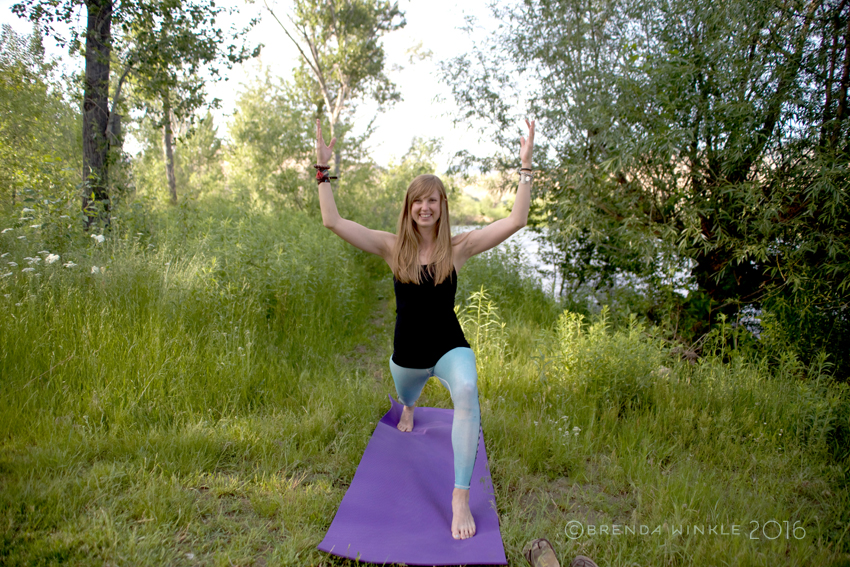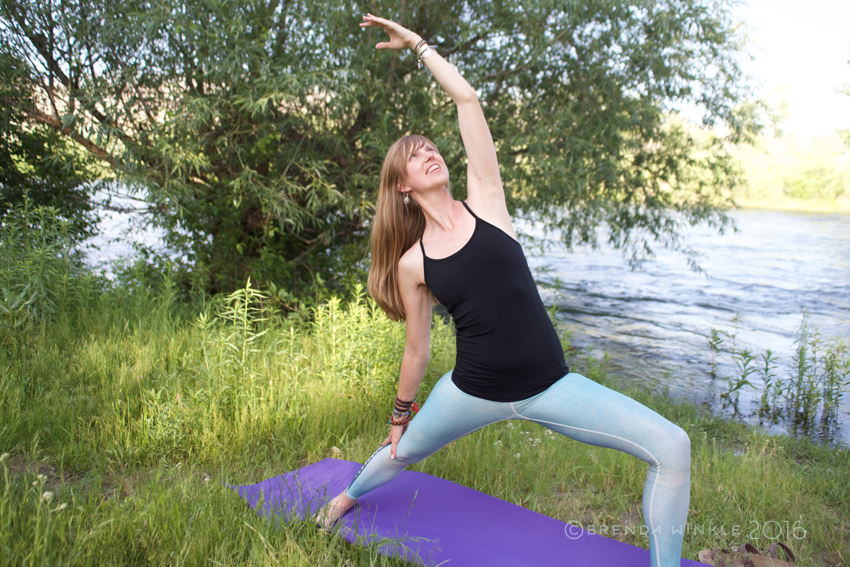Trauma-Sentive yoga: An interview with Caitlin Lanier
May 14, 2016
Have you ever thought of yoga as a healing modality? All yoga can be healing. In particular, trauma-sensitive yoga can be very healing for anyone who has lived through a physical or emotional trauma.
For me, yoga was instrumental in my healing from the PTSD I suffered as a result of an abusive marriage. I knew that other people also have found healing in yoga so I’ve included a chapter on it in the book I’m working on. As part of the research I’m doing, I asked the owner my yoga studio to sit and talk with me about the healing power of yoga. She agreed! (you’ll hear from her later) She suggested I speak with a fabulous woman who specializes in Trauma-Sensitive Yoga named Caitlin Lanier. Caitlin Lanier is a social worker and yoga teacher living in Boise, Idaho.
Caitlin is trained as a Trauma-Sensitive Yoga teacher and has pioneered several trauma-sensitive yoga programs—including one at a domestic violence shelter, two at universities (Boise State University and College of Idaho), and two working with refugees at St. Alphonsus Medical Group and Tidwell Social Services.. Like me, Caitlin has firsthand knowledge of the healing power of yoga. A sexual assault in 2004 left her feeling damaged, ashamed and depressed. Yoga has helped her find her way toward wholeness again after the grief and trauma from the assault led to self-destructive behaviors.
I took one of Caitlin’s specialty classes on self-care at Yoga Tree of Boise and saw her techniques at work. Caitlin’s techniques are simple, profound and amazing. They allow you to feel safe which allows you to go deeper into the meditative movement that yoga becomes.
I knew in that class Caitlin was someone I wanted to know and to call my friend. I was thrilled when she wanted to talk with me about trauma-sensitive yoga.

Why yoga for healing?
The word yoga means union. Yoga is literally a union of mind, body and spirit. This is what makes yoga such a great choice for so many people. It is a way to slow down and connect our spiritual body to our emotional body and our physical body. This is also why yoga is incredibly healing.
There are a lot of people who have found the healing of yoga to be a way to heal from abuses, assaults and other traumas; eating disorders, depression, a wide range of physical issues and more. When we go through something difficult, one of the side effects can be a displaced hatred onto our bodies. This is especially true in cases of physical, sexual or verbal abuse/assault. That was absolutely the case for me. Yoga helped heal my body, spirit and mind as I recovered from the effects of an abusive relationship. Yoga helped me learn about my body and to, as Caitlin said in a Huffington Post interview with Rob Schware, yoga helped me befriend my body. You can view that interview by clicking here.
The following was taken from our conversation.

What is trauma-sensitive yoga?
Trauma-sensitive yoga is rooted in the understanding that people are the experts of their own bodies and experiences. Trauma-sensitive yoga attempts to flatten the power dynamic present in the student-teacher relationship by giving students back the power and autonomy over their bodies, movements, and experiences by offering invitations and opportunities, not commands and requirements. In trauma-sensitive yoga, the teacher uses invitational language. For example, “I invite you…”, “If you’d like…”, “Maybe,…”, “One option is X, another option is Y,” etc. People who have been through trauma have a distinct experience of disempowerment and therefore need to be empowered to be in control of their own bodies and movements and to make autonomous decisions about their own bodies.
Teachers trained in trauma-sensitive yoga by and large adhere to a no-adjustments philosophy. In some studio yoga classes, teachers will physically adjust students to correct poses by placing their hands on a student’s body in a constructive manner to help move their bodies into the correct form of the pose.
In trauma-sensitive yoga, the teacher does not make physical contact with the student to make adjustments. Physical touch can be a trigger for people who have experienced physical trauma. It can be a well-meaning attempt at helping that leaves a yoga student feeling violated, triggered and re-living horrific memories. All people, really, should have control over who touches their body. For a person who has lived through a sexual or physical trauma, this is a critical component in helping them feel safe.
Yoga is an ancient scientific wellness system for the mind, body and spirit. It can be a journey to wholeness. Evidence shows that trauma-sensitive yoga can decrease the hyper-arousal that PSTD sufferers experience. Yoga can significantly decrease anxiety. (Source)
There is promising evidence coming from the mental health arena as well on the healing effects of yoga for trauma, including PTSD. Many times, people who have been traumatized feel re-victimized by some traditional counseling methods that force them to re-live their traumatic experiences detail by detail. Both Caitlin and I have experienced variations of this, where a counselor left us feeling more damaged than healed. (Source) This is not to say that there isn’t a place for traditional counseling in healing from trauma. However, be absolutely certain the counselor you choose is an expert in dealing with the kind of trauma you experienced.
There is a growing body of promising evidence that trauma-sensitive yoga has widespread applications for not only victims of violence or abuse, but for combat-related trauma. (Source)

How did you find trauma sensitive yoga?
When Caitlin was growing up, she participated in ballet dancing. In ballet, it was all about perfection. This pursuit of perfection led to some unhealthy behaviors, particularly after the sexual assault. Caitlin took a 6-week elective yoga course and began to wonder, “Why am I still hurting myself?” She wondered, “What if…. I tried to take care of myself as well as I could?”
This curiosity led to more yoga and to trail running. Caitlin’s pursuit of perfection was replaced by embracing imperfection, the kind we all have. Through the trail running, Caitlin found she was reacquainting herself with her body and building up strength.
Through yoga, Caitlin found that she was reconnecting with herself. She was developing an awareness of herself and her body. She found herself healing. Ultimately, this led to Caitlin not only developing a yoga practice, but becoming a teacher specializing in trauma-sensitive yoga.
In the trauma-sensitive yoga classes, it’s fairly rare for participants to verbally process their trauma histories. The main focus of the yoga class is to notice the present moment in the body right now, rather than what has happened in the distant past. It is known when walking in to the class that there is a shared experience of trauma, but it is not the focus. The focus is on healing, on reclaiming bodies as their own.
In abuse and trauma, people find they have no autonomy to change. They lack control to make even basic decisions about their bodies. Little by little, yoga teaches people they can control their own bodies, they can love their own bodies. And this is real healing. It is a healing that can be universally experienced even among people who haven’t experienced trauma.
Healing power of yoga
You can experience the healing power of yoga even if you don’t have access to trauma-sensitive yoga. Let your yoga teacher know if you do not want to be touched in class. This is particularly important if you have issues around being touched. You can say this to a new teacher as simply as “I prefer you not make any physical adjustments to me in class.”
Yoga is the union of YOUR mind, body and spirit. Give yourself permission to find your own yoga. If a pose really isn’t working for you or you feel pain, either ask for a modification or go into something you know works for you. Yoga beginners, it’s always ok to go into child’s pose if you need a break for any reason. It’s a universal rest pose. Don’t be afraid to ask for help if you do need help figuring out a pose.
Most yoga teachers want you to find your yoga. That’s my hope for you, too. Here is to healing!
Caitln’s website is http://yogisites.com/caitlinlanier. Please visit her there! HUGE thanks to Caitlin for sharing her story with me (and you!) and for helping me write this post.
If you enjoyed this post, please share it! My mission is always to spread love and light far and wide. In this particular case, Caitlin and my combined mission is to share that healing is out there for anyone ready to receive it.
If you are in danger or know someone who might be, please contact the authorities or visit http://www.thehotline.org. If you are on your home computer and fear you are in danger, it would be better to visit the site from another computer to keep yourself safe.
All my love,
Brenda
Follow me on Facebook here.
Follow me on Twitter here.
Follow me on Instagram here.
